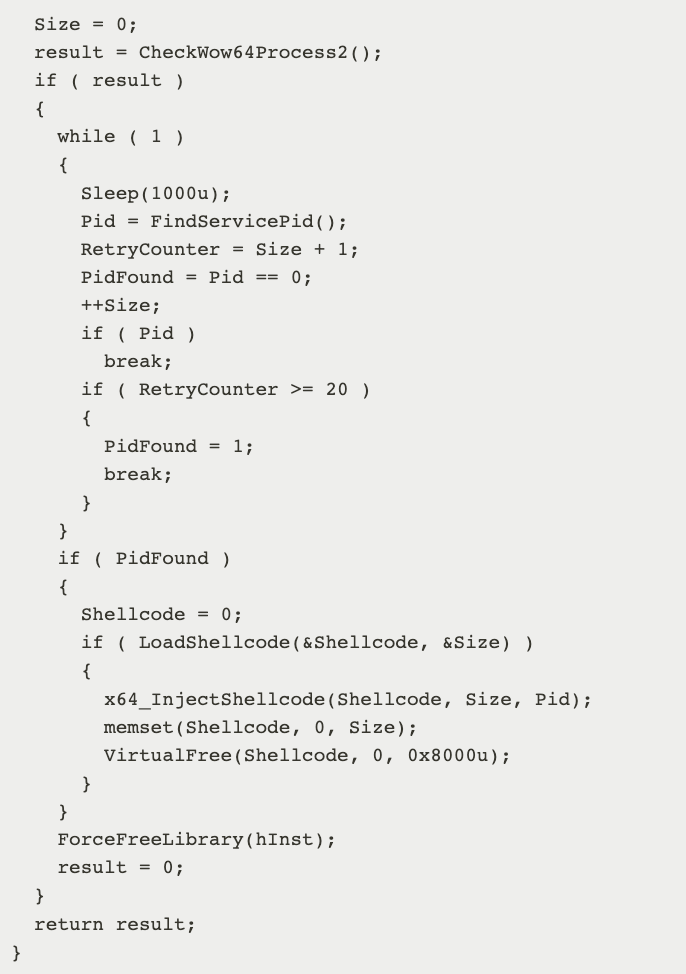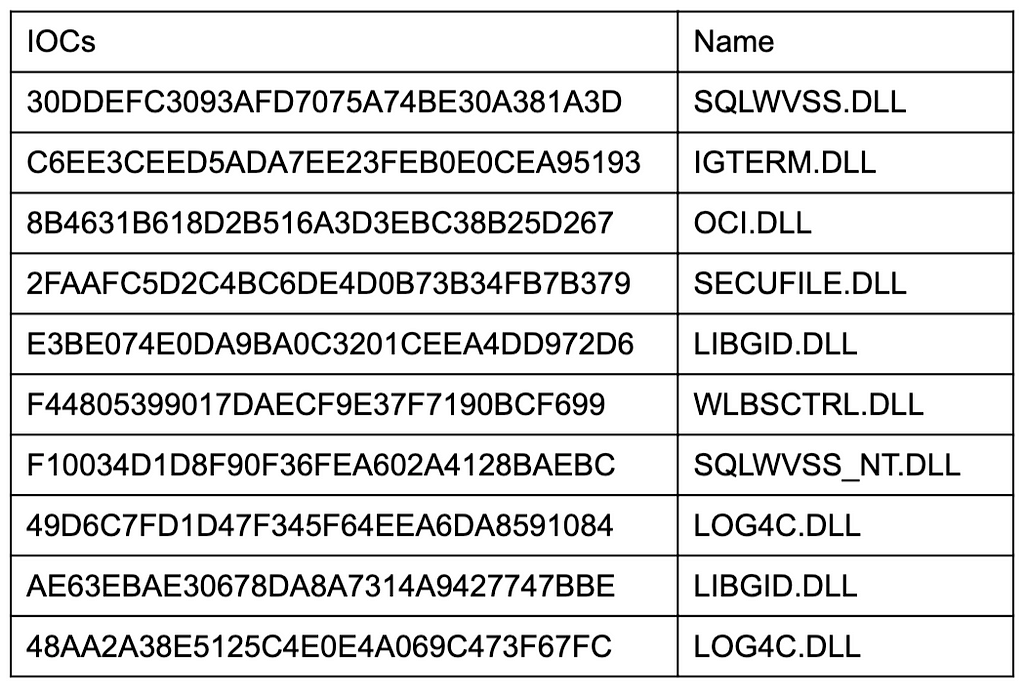Part 1: Waterbear Malware
In April 2020, highly malicious cyber activity was detected in several Taiwan government agencies. In one environment alone, out of the thousands of endpoints scanned, 30 endpoints were confirmed to be infected, and 10 high-risk endpoints were connected by these compromised endpoints. 10 key malware were discovered during these sophisticated targeted attacks — most of them were Waterbear Loader malware.
 CyCraft AIR assigns Threat Level 10 to the most severe and most damaging malware.
CyCraft AIR assigns Threat Level 10 to the most severe and most damaging malware.Highlighted Tactics
The attackers discovered and leveraged a weak point in trusted and commonly used data loss prevention (DLP) software in order to trigger malware and maintain persistence. The government agencies targeted for attack in April 2020 had already been compromised prior to the April attacks; however, CyCraft AIR (our automated detection and response platform) discovered that not all the malware from the previous attack was removed during another vendor’s IR investigation, allowing the attackers to use the previously compromised endpoints yet again.
The discovered Waterbear Loader malware used several methods to evade defense. (Each method will be expanded upon later in the article.)
- DLL hijacking to stealthily trigger next stage malware
- Enlarging binary size to bypass scanning protocols
- Heaven’s Gate to avoid antivirus detection
- Forcing DLLs to unload to obfuscate malware
- Padding memory with Kernel32 content to confuse analyses
Network Level Activity
The attackers first compromised a user’s endpoint to harvest administrative credentials. The credentials were then utilized to RDP a web server. With the connectivity of the web server, the attackers “net use” through (proxying) the webserver, allowing them to distribute malware directly to other endpoints.
As mentioned before, several malware was not removed from a previous IR investigation. One endpoint in the victim’s private network was still compromised. The attackers used this previously compromised endpoint in the victim’s private network as the C2 server for this attack.
System Level Activity
DLL Hijacking
One key feature of this attack was DLL Hijacking.
What is DLL Hijacking?
A DLL hijacking attack exploits the Windows search and load mechanism, allowing attackers to inject code into applications through disk manipulation. By simply injecting a DLL file in the right location, attackers can cause vulnerable applications to load malicious DLLs.
The attackers leveraged a DLL hijacking vulnerability in the DLP software to enlarge its defensive evasion capability and to persistently trigger next-stage malware. However, the DLP software failed to verify the integrity of their loaded DLLs. Thus the DLP software loaded the malicious DLL with high privilege.
 DLL Hijacking Flowchart
DLL Hijacking FlowchartThe attacker modified LOG4C.DLL to implant a new entry in the import table. The new entry will enforce the DLP software to load the malicious SecureFile.dll (or LIBDIG.dll). The loaded DLL then injects shellcode to system services, including Winmgmt, sens, Wuauserv and LanmanServer. Then, the next-stage malware payload is invoked to communicate to the C2 server.
Next-Stage Malware
C[:]\PROGRAM FILES\XYZ\AGENT\ExportAgentConfig[.]dat
C[:]\Windows\PolicyDefinitions\TrayBar.admx
 Malicious machinations are lurking within LOG4C.DLL
Malicious machinations are lurking within LOG4C.DLL SECUFILE.DLL is up to no good. CyCraft AIR detected the malware within the DLL.
SECUFILE.DLL is up to no good. CyCraft AIR detected the malware within the DLL.Increased Size
File-based scanners sometimes skip the scanning of larger files to maintain performance. The attackers enlarged the file size to bypass scanning altogether. The original size of file oci[.]dll is 66.5 KB however, as the above screenshot of CyberTotal demonstrates, oci[.]dll had been enlarged to 130 MB. Thus allowing it to be ignored by numerous security scanning tools.
 Size Matters
Size MattersWindows IKEEXT Service Abuse
The threat actor made use of Windows IKEEXT Service to load even more malware into memory — WLBSCTRL.DLL. Windows IKEEXT Service is a service for APN authentication that is disabled in the default Windows setting. This service is widely abused by attackers we observe.
 WLBSCTRL.DLL
WLBSCTRL.DLLWaterbear Loader Malware Analysis
File Metadata
filename: libgid.dll
md5: e3be074e0da9ba0c3201ceea4dd972d6
sha1: cd8f49e467cf2f630c7f3b38a2e4c30e7bac6466
sha256: e69690e4f94a60678aefc3adb80eef484bb5ca4285a2d3aabc1bb8d975fb7610
filetype: PE32 executable (DLL) (GUI) Intel 80386, for MS Windows
family: Waterbear Loader
Indicator
file_path: C[:]\Windows\PolicyDefinitions\TrayBar.admx
RICH Header

The Waterbear Loader malware resurrected a 10-year-old antivirus evasion technique known as Heaven’s Gate. In this particular case, the attackers applied Heaven’s Gate to inject shellcode into the 64-bit system service from 32-bit WoW64.
Just as 64-bit and 32-bit programs are quite different, so are analysis mechanisms. Malware equipped with Heaven’s Gate contains both 64-bit and 32-bit parts. Therefore, some monitor/analysis systems will only apply 32-bit analysis and will fail the 64-bit part; thus, this approach will break some monitor/analysis mechanisms.
Waterbear Loader forced itself to be unloaded, allowing it to evade detection from some memory forensic tools.
What is Heaven’s Gate?
This antivirus evasion technique permits 32-bit malware to hide API calls by switching to a 64-bit environment. Malware typically remains hidden inside the loader making it difficult for the AV to detect.
While Heaven’s Gate was first considered to be an advanced technique, over the last decade the Heaven’s Gate exploit has been observed in more and more rootkits as well as other malware, such as the infamous Emotet trojan.
Even though usage of the Heaven’s Gate spread, Microsoft’s release of Control Flow Guard (CFG) in Windows 10 immediately hindered the exploit’s effectiveness as CFG prevented code jumps from WoW64 32-bit execution to native 64-bit code execution space. However, like most exploits, attackers still equip them when targeting legacy systems and the like — further demonstrating the need for organizations to update defenses early and update them often.
Behavior

- Waterbear Loader first checks whether the current execution context is WoW64, and looks for Winmgmt, sens, Wuauserv, LanmanServer to inject the shellcode.
- Then, Waterbear Loader uses xor to decrypt strings in file with key 0x2a361c78
- Waterbear Loader reads the encrypted payload.
In this case: C:\Windows\PolicyDefinitions\TrayBar.admx - Then uses RC4 to decrypt it with key: 690c402f435878175d454028455a751b5372791e4358750c4359720b76626e1953747d0a0457781552361c78
- In an attempt to further confuse analysis, Waterbear Loader padded contents from Kernel32.dll in front of and behind their shellcode.
- Used x64_InjectShellcode to inject shellcode to the previously found service by Heaven’s Gate.
- In the end, the LdrData data is modified and forced to free the library by FreeLibraryAndExitThread.


MITRE ATT&CK®
The following MITRE ATT&CK techniques were observed in this attack.
Persistence
T1547.001 Registry Run Keys/ Startup Folder
T1574.001 DLL Search Order Hijacking
Privilege Escalation
T1574.001 DLL Search Order Hijacking
Defense Evasion
T1574.001 DLL Search Order Hijacking
T1027.002 Software Packing
T1070.006 Timestop
Lateral Movement
T1021.001 Remote Desktop Protocol
IOCs

Mitigation
1. Add listed IOCs to preventative solution blacklists.
2. Adjust detection and response solutions to detect listed IOCs.
3. Meticulously tracking down the root cause of the attack (not just the endpoint) and thoroughly removing malware is not only paramount in an IR investigation but could also prevent future attacks.
4. As DLP software is widely deployed in sensitive organizations, is daily-used software, and often has high privilege, DLP vendors and customers both need to constantly be striving on hardening security to maintain resilience even in the worst of situations.
5. Do not rely on a one-solution security policy. Preventative solutions (e.g., firewalls, antivirus) and DLP solutions are no longer enough to maintain resilience during an attack of this sophistication. AI-driven detection and response solutions, such as our award-winning CyCraft AIR, not only reduce mean dwell time but also increase SOC efficiency, automate investigations, and reduce alert fatigue.
Follow Us
Blog | LinkedIn | Twitter | Facebook | CyCraft

When you join CyCraft, you will be in good company. CyCraft secures government agencies, Fortune Global 500 firms, top banks and financial institutions, critical infrastructure, airlines, telecommunications, hi-tech firms, and SMEs.
We power SOCs with our proprietary and award-winning AI-driven MDR (managed detection and response), SOC (security operations center) operations software, TI (threat intelligence), Health Check, automated forensics, and IR (incident response), and Secure From Home services.
Additional Related Resources
- Learn how we detected and defeated a China-sponsored APT targeting Taiwan’s high-tech ecosystem. Read our full analysis and malware reversal.
- Using ATT&CK for CTI Training | MITRE ATT&CK®
- ATT&CK Evaluations: Understanding the Newly Released APT29 Results
- CyCraft Classroom: MITRE ATT&CK vs. Cyber Kill Chain vs. Diamond Model
- Quantifying the MITRE ATT&CK Round 2 Evaluation
- CyCraft CEO, Benson Wu, and CyCraft Global Project Manager, Chad Duffy, speak on the latest MITRE ATT&CK Evaluations. Read their thoughts on our results and the philosophy powering CyCraft.
- Has your organization shifted to a Work From Home environment? Learn how to receive Three FREE months of our Secure From Home Service.
- Our Enterprise Health Check drops your mean dwell time down from 197 days to under 1 day without false positives or false negatives. Know with confidence if hackers have penetrated your enterprise.
READY FOR A DEMO?
Contact us directly for more details: [email protected]
Taiwan Government Targeted by Multiple Cyberattacks in April 2020 was originally published in CyCraft on Medium, where people are continuing the conversation by highlighting and responding to this story.
Article Link: Taiwan Government Targeted by Multiple Cyberattacks in April 2020 | by CyCraft Technology Corp | CyCraft | Medium
